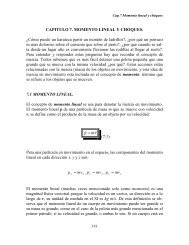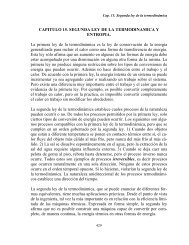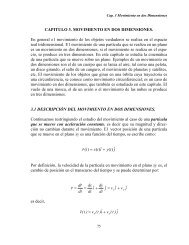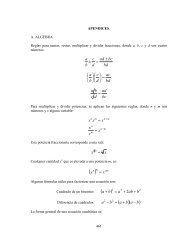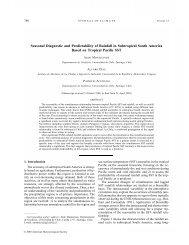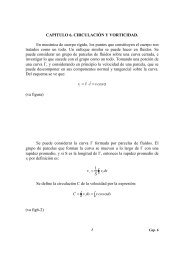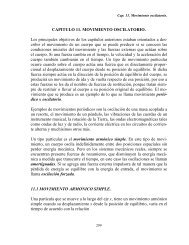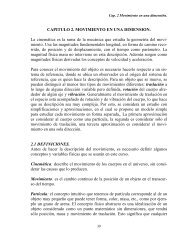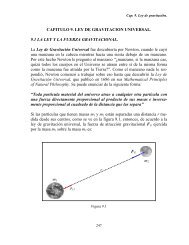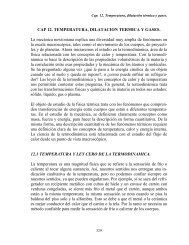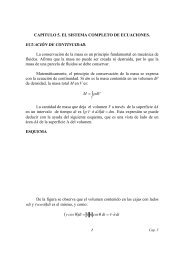Capítulo 13. Calor y la primera ley de - DGEO
Capítulo 13. Calor y la primera ley de - DGEO
Capítulo 13. Calor y la primera ley de - DGEO
You also want an ePaper? Increase the reach of your titles
YUMPU automatically turns print PDFs into web optimized ePapers that Google loves.
Cap. <strong>13.</strong> <strong>Calor</strong> y <strong>la</strong> Primera Ley <strong>de</strong> <strong>la</strong> Termodinámica<br />
Ejemplo <strong>13.</strong>5. Calcu<strong>la</strong>r <strong>la</strong> cantidad <strong>de</strong> calor necesario para transformar un<br />
gramo <strong>de</strong> hielo a -30º C en vapor <strong>de</strong> agua hasta 120º C.<br />
Solución: es conveniente analizar cada proceso físico en forma separada. El<br />
subíndice H se refiere <strong>la</strong> hielo, el A al agua y el V al vapor.<br />
1º) cálculo <strong>de</strong>l calor que se le <strong>de</strong>be agregar al hielo para elevar su temperatura<br />
<strong>de</strong>s<strong>de</strong> -30º C hasta 0º C; en este proceso hay cambio <strong>de</strong> temperatura, se calcu<strong>la</strong><br />
el calor sensible Q1:<br />
Q1 = mH cH ∆T, con cH = 2090 J/kg ºC<br />
−3<br />
⎛ J ⎞<br />
Q1 = ( 10 kg)<br />
⎜2090<br />
⎟<br />
7<br />
⎝ kgº<br />
C ⎠<br />
375<br />
[ 0 − ( −30)<br />
] º C = 62.<br />
J<br />
2º) calor agregado para fundir el hielo (en 0º C), no hay cambio <strong>de</strong> temperatura,<br />
pero hay cambio <strong>de</strong> fase, se calcu<strong>la</strong> el calor <strong>la</strong>tente Q2:<br />
Q2 = mLFH, con LFH = 3.33x10 5 J/kg<br />
−3<br />
⎛<br />
5 J ⎞<br />
Q2 = ( 10 kg)<br />
⎜3.<br />
33×<br />
10 ⎟ = 333J<br />
⎝ kg ⎠<br />
3º) cálculo <strong>de</strong>l calor que se le <strong>de</strong>be agregar al agua para aumentar su temperatura<br />
<strong>de</strong>s<strong>de</strong> 0º C hasta 100º C; en este proceso hay cambio <strong>de</strong> temperatura, se<br />
calcu<strong>la</strong> el calor sensible Q3:<br />
Q3 = mA cA ∆T, con cA = 4186 J/kg ºC<br />
−3<br />
⎛ J ⎞<br />
Q3 = ( 10 kg)<br />
⎜4186<br />
⎟(<br />
100 − 0)º<br />
C = 418.<br />
6J<br />
⎝ kgº<br />
C ⎠<br />
4º) calor agregado para evaporar el agua (en 100º C), no hay cambio <strong>de</strong> temperatura,<br />
pero hay cambio <strong>de</strong> fase, se calcu<strong>la</strong> el calor <strong>la</strong>tente Q4:<br />
Q4 = mLVA, con LVA = 22.6x10 5 J/kg



